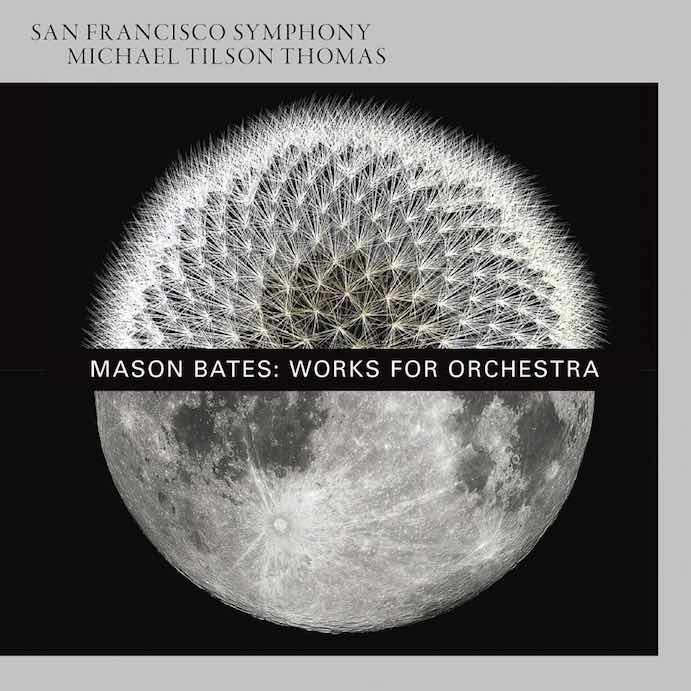Works for Orchestra is Mason Bates‘ latest album released under San Francisco Symphony‘s SFS Media label. The CD consists of three major compositions from the San Francisco-based composer–The B-Sides, Liquid Interface, and Alternative Energy–all recorded live at the Davies Symphony Hall in 2014 and conducted by Michael Tilson Thomas. Each piece contains movements with curious titles that sound like chapters from a science fiction novel, yet this ability to conjure familiar imaginary worlds is what makes Bates’ music so captivating to listen to.
Works for Orchestra begins with The B-Sides (2009), a series of symphonic pieces that make an explicit reference to the physical format of vinyl records. Bates is particularly inspired by hip hop singles where A-Side tracks are more catchy to the ear, while B-Side tracks are more experimental in nature. As such, The B-Sides immerses its audience in a series of exploratory soundscapes ranging from dusty circuit boards to the techno scene in 90s Detroit. In the first movement entitled “Broom of the System,” Bates uses precise electronic clicks, an actual broom brushing against cardboard, and a churning string section punctuated by woodwinds and brass to convey a morphing rhythmic groove. “Warehouse Medicine,” on the other hand, is more industrial sounding and consistent in its attack even though the instrumentation is much the same. “Aerosol Melody (Hanalei)” transports us to the sunny, easygoing shorelines of Kauai, “Temescal Noir” takes us to the hazy streets of Oakland at night time, while “Gemini in the Solar Wind” sends us into space with its clever usage of NASA archival recordings nestled inside a suspenseful ambient score. When heard altogether, The B-Sides is a musical journey that unravels like a phantasmagoria, as if some long forgotten soundtrack from the early days of cinema was being brought back to life in our present day context.

Mason Bates
Bates’ ability to sample the orchestra in different ways while integrating electronic elements with such ease is impressive and certainly deserving of praise. The other two works on his album, Liquid Interface (2007) and Alternative Energy (2011), are also fine examples of the composer’s savviness with electro-acoustic palettes. Liquid Interface pays homage to water as it transitions between its natural states, starting with “Glaciers Calving” and ending “On The Wannsee.” Of particular interest are the two movements sandwiched in the middle entitled “Scherzo Liquido” and “Crescent City.” “Scherzo Liquido’s” rolling cascade of drips are delightful to the ears and inventive in the complexity of their textures; “Crescent City” blossoms into a grandiose Dixieland swing before being overtaken by a terrifying and unexpected storm at the end of the movement. The San Francisco Symphony’s performance is stellar given the way they handle all the stylistic twists and turns that the score throws their way.
Last on the album is Alternative Energy (2011), a symphony in four movements for orchestra, laptop, and a set of speakers arranged around the orchestra so as to create a spatial effect in performance. Even though listeners of the CD are not able to experience this effect, the piece is recorded and mixed well enough to not seem ‘flat’ in terms of acoustics. The concept behind Alternative Energy is simple: what does energy–a vital resource on which we all depend–sound like? Bates then adds in the element of time travel, beginning with the junkyard clamour of “Ford’s Farm, 1896” before bringing us closer to “Chicago, 2012” and the city’s nearby Fermilab particle collider. The next two movements skip ahead to the dark wasteland of “Xinjiang Province, 2112,” followed by the return of “Ford’s Farm’s” solitary fiddler as she navigates the dystopian landscape of “Reykjavik, 2222.” After hearing the rest of the album, however, Alternative Energy starts to sound a bit similar to everything else. That said, Mason Bates’ multifarious style is not at fault. Given the intense concentration of details within each piece, Bates’ music would do best if placed in a program or track listing that allows listeners to take a breath in between.
Works For Orchestra serves as an innovative blueprint of what’s possible, a pivotal showcase of what’s necessary, and a promising indication of what’s to come. There is still so much untapped potential in combining orchestral timbres with digital forms of music making, but this album moves us many positive steps forward in that direction.

